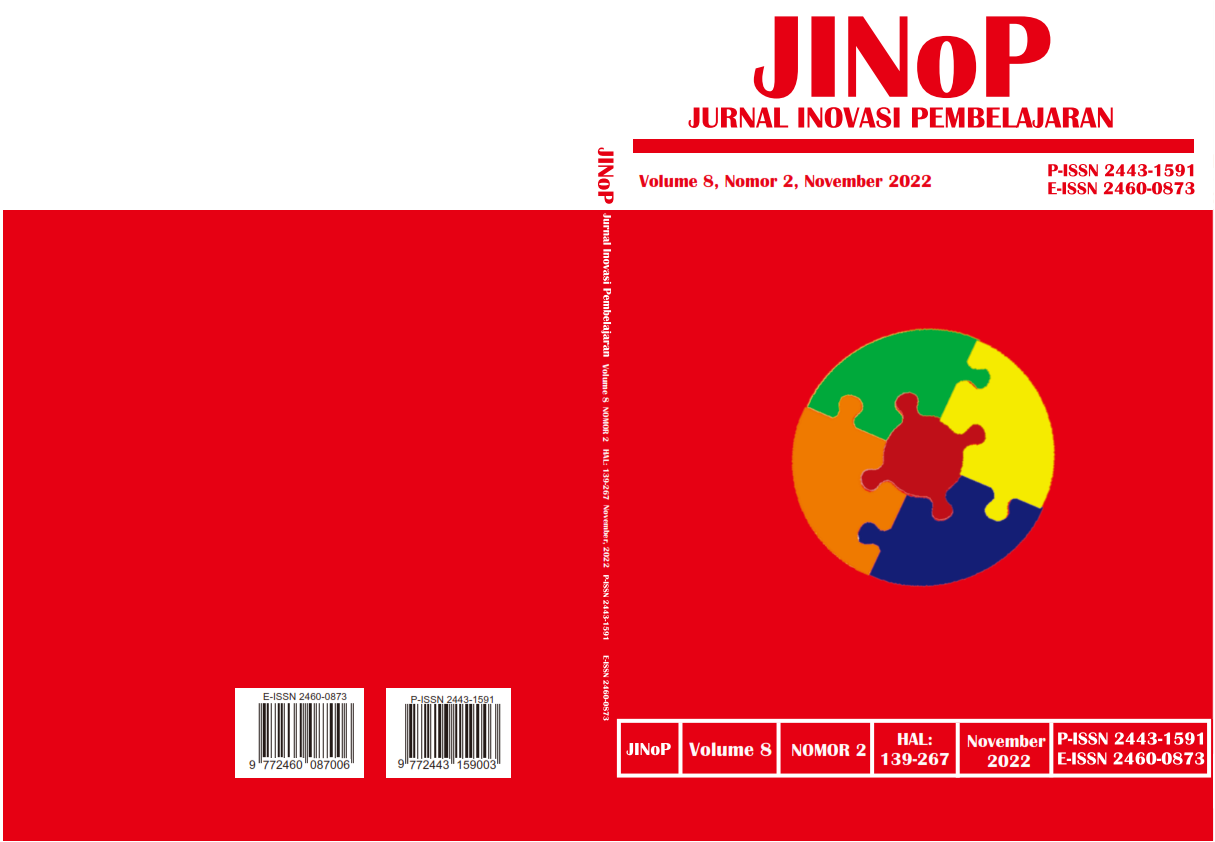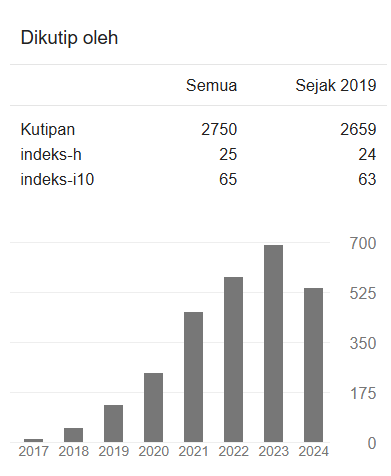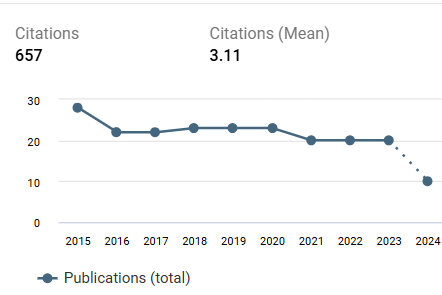Pengembangan video animasi pembelajaran matematika berbasis nilai-nilai kewirausahaan di sekolah dasar
DOI:
https://doi.org/10.22219/jinop.v8i2.19462Keywords:
Animated Video, Animation Maker, Mathematics Learning, Entrepreneurial ValueAbstract
Increasing entrepreneurial values in practice needs to be supported by good learning media. This project is intended to create animated video media for learning mathematics based on entrepreneurial principles for second graders of elementary school. The research employed Research and Development (R&D) develoipmental model by using the ADDIE method. Two media experts, two material experts, and one linguist expert served as the research subjects. User responses from the results of the implementation consisted of 2nd grade homeroom teachers and 38 students in 2nd grade of SD Negeri 8 Air Gegas in South Bangka. The data collection method employed questionnaires and observation as the instrument of the research. An average rating of 90.2% from media professionals was reached after considering the opinions of material specialists, linguists, and media experts. Based on the assessment of media experts, material experts, and linguists, an average percentage of media experts' assessment of 90.2% with very appropriate criteria, 82.5% of material experts with very feasible criteria, and 88.4% of linguists with very feasible criteria was obtained. Based on the responses of students and teachers, it was obtained an average percentage of students' assessment of 95% with very practical criteria and 89.4% of teachers with very practical criteria. While the results of the post test obtained an average percentage of 86.2% with very effective criteria. This research drew the conclusion that the media produced using the Animaker software is very feasible and practical to be implemented in learning and is effective in efforts to increase entrepreneurial values in students. The research suggested that the media can be used by teachers in the learning process by paying attention to other supporting facilities, while in further research to be able to measure the implementation of this media over a longer period of time using learning outcomes instruments.
Downloads
References
Ahern, T. C. (2016). A Waterfall Design Strategy for Using Social Media for Instruction. Journal Of Educational Technology Systems, 44(3), 332–345. https://journals.sagepub.com/doi/10.1177/0047239515615853
Alfin, J. (2018). Membangun Budaya Literasi dalam Pembelajaran Bahasa Indonesia Menghadapi Era Revolusi Industri 4.0. Pentas: Jurnal Ilmiah Pendidikan Bahasa Dan Sastra Indonesia, 4(2), 60–66. https://jurnal.univpgri-palembang.ac.id/index.php/Prosidingpps/article/ view/2511
Allolinggi, L. R. (2013). Analisis Nilai-Nilai Kewirausahaan Dalam Pembelajaran IPS Di Sekolah Dasar (Studi Kasus pada Siswa Kelas IV SDPN Pajagalan 58 Bandung). Universitas Pedidikan Indonesia.
Ariyana, A., Ramdhani, I. S., & Sumiyani, S. (2020). Merdeka Belajar melalui Penggunaan Media Audio Visual pada Pembelajaran Menulis Teks Deskripsi. Silampari Bisa: Jurnal Penelitian Pendidikan Bahasa Indonesia, Daerah, Dan Asing, 3(2), 356–370. https://doi.org/10.31540/silamparibisa.v3i2.1112
Avvisati, F., Echazarra, A., Givord, P., & Schwabe, M. (2019). Programme For International Student Assessment (PISA) Results From PISA 2018. OECD Journal, I(III), 1–10. https://www.oecd-ilibrary.org/education/pisa-2018-results-volume-iii_bd69f805-en%0A
Awalia, I., Pamungkas, A. S., & Alamsyah, T. P. (2019). Pengembangan Media Pembelajaran Animasi Powtoon pada Mata Pelajaran Matematika di Kelas IV SD. Jurnal KREANO, 10(1), 49–56. https://doi.org/10.15294/kreano.v10i1.18534
Baber, H. (2021). Modelling the acceptance of e-learning during the pandemic of COVID-19-A study of South Korea. International Journal of Management Education, 19(2), 100503. https://doi.org/10.1016/j.ijme.2021.100503
Batty, M., Collins, J. M., & Odders-White, E. (2015). Experimental Evidence on the Effects of Financial Education on Elementary School Students’ Knowledge, Behavior, and Attitudes. The Journal of Consumer Affairs, 49(1), 69–96.
Daga, A. T. (2021). Makna Merdeka Belajar dan Penguatan Peran Guru di Sekolah Dasar. Jurnal Educatio, 7(3), 1075–1090. https://doi.org/10.31949/educatio.v7i3.1279
Delgadillo, L. M. (2014). Financial Clarity: Education, Literacy, Capability, Counseling, Planning, and Coaching. Family & Consumer Science, 43(1), 18–28.
Elonge, M. (2013). An Evaluation of Financial Literacy in Elementary Schools towards Financial Education Enhancement: A Case Study of Baltimore Public Schools. Literacy Information and Computer Education Journal, 4(4), 1283–1291. https://doi.org/10.20533/licej.2040.2589.2013.0170
Fitroni, Z. (2017). Peningkatan Minat Kewirausahaan Siswa Smp Dengan Pendekatan Scientific Sell. JINOP, 3(2), 659–670.
Hasbullah, H. (2018). Peningkatan Hasil Belajar Kognitif Biologi Menggunakan Model Problem Base Learning Berbasis Powtoon Siswa Kelas XII IPA 7 SMA N 1 Metro Semester Ganjil Tahun Pelajaran 2017/2018. BIOEDUKASI (Jurnal Pendidikan Biologi), 9(2), 124. https://doi.org/10.24127/bioedukasi.v9i2.1623
INPRES. nomor 4 tahun 1995. tentang gerakan nasional memasyarakatkan dan membudayakan kewirausahaan, (1995).
Julianto, I. N. L., Cahyadi, I. W. A. E. C., & Artawan, C. A. (2019). Interaktivitas Warna Sebagai Rangsang Visual Pada Ruang Belajar Siswa Sekolah Dasar Kelas 1 – 3 Di Kota Denpasar (Color Interactivity as Visual Stimulation in the Study Room of Grade 1-3 of Elementary Students in Denpasar City. Seminar Nasional Sandyakala, 56–64. https://eproceeding.isi-dps.ac.id/index.php/sandyakala/article/download/39/33/
Kemendikbud, T. G. (2017). Materi Pendukung Literasi Finansial. In Kementerian Pendidikan dan Kebudayaan. http://gln.kemdikbud.go.id/glnsite/buku-literasi-finansial/
Kusuma, A. I., & Pramesti, D. (2018). Kontribusi Kemampuan Teacherpreneur Pada Kualitas Daya Saing. Seminar Nasional Dewan Pendidikan Provinsi Kepulauan Bangka Belitung: Pendidikan Di Era Milenial, 1–17.
Latif, Y., Darmawijoyo, & Putri, R. I. I. (2013). Pengembangan Bahan Ajar Berbantuan Camtasia pada Pokok Bahasan Lingkaran melalui Edmodo untuk siswa MTs. Jurnal KREANO, 4(2), 105–114. https://doi.org/10.15294/kreano.v4i2.2937
Lestari, S. (2018). Peran Teknologi dalam Pendidikan di Era Globalisasi. Edureligia; Jurnal Pendidikan Agama Islam, 2(2), 94–100. https://doi.org/10.33650/edureligia.v2i2.459
Mashuri, D. K. (2020). Pengembangan Media Pembelajaran Video Animasi Materi Volume Bangun Ruang untuk SD Kelas V. JPGSD, 8(5), 893–903.
Ngafifi, M. (2014). Kemajuan Teknologi Dan Pola Hidup Manusia Dalam Perspektif Sosial Budaya. Jurnal Pembangunan Pendidikan: Fondasi Dan Aplikasi, 2(1), 33–47. https://doi.org/10.21831/jppfa.v2i1.2616
Nomleni, F. T., & Manu, T. S. N. (2018). Pengembangan Media Audio Visual dan Alat Peraga dalam Meningkatkan Pemahaman Konsep dan Pemecahan Masalah. Scholaria: Jurnal Pendidikan Dan Kebudayaan, 8(3), 219–230. https://doi.org/10.24246/j.js.2018.v8.i3.p219-230
Pramesti, D., & Kusuma, A. I. (2020). Implementasi Nilai Kewirausahaan Jenjang Sekolah Dasar Pada Sekolah Mitra Stkip Muhammadiyah Bangka Belitung Di Kecamatan Gabek Kota Pangkalpinang. Jurnal Ekonomi Dan Pendidikan, 17(1), 1–6. https://doi.org/10.21831/jep.v17i1.29256
Riduwan. (2013). Skala Pengukuran Variabel-Variabel Penelitian. Alfabeta.
Rindawati, R., Khosyi’Atunnisa, S., & Herlambang, R. (2021). Pemanfaatan TIK dalam Pengembangan Sumber Dan Media Pembelajaran Di Era Society 5.1. Jurnal FATEKSA: Jurnal Teknologi Dan Rekayasa, 6(2), 24–31. https://uswim.e-journal.id/fateksa/article/view/263
Riyanti, R., & Rusdi, H. (2018). Efektivitas Penggunaan Game Edukasi Smartphone Terhadap Hasil Belajar Dan Motivasi Belajar Mahasiswa Pendidikan Biologi STKIP YAPIM MAROS. Jurnal Ilmiah Pena, 1(2), 21–28. http://ojs.stkippi.ac.id/index.php/jip/article/view/148
Rochimah, S. (2019). Pengembangan Media Pembelajaran Berbentuk Video Animasi Pada Pokok Bahasan Keliling Dan Luas Segitiga Untuk Meningkatkan Minat Belajar Siswa Di Kelas Iv Sekolah Dasar Negeri Sumberagung Peterongan Jombang. In Skripsi.
PERMENDIKBUD, republik indonesia nomor 57 tahun 2014 tentang kurikulum 2013 sekolah dasar/madrasah ibtidaiyah kerangka dasar kurikulum dan struktur kurikulum sekolah dasar/madrasah ibtidaiyah i., (2014). http://www.akrabjuara.com/index.php/akrabjuara/article/view/919
Setiawan, A. R. (2020). Pendidikan Literasi Finansial Melalui Pembelajaran Fiqh Mu’Āmalāt Berbasis Kitab Kuning. Nazhruna: Jurnal Pendidikan Islam, 3(1), 138–159. https://doi.org/10.31538/nzh.v3i1.522
Sudaryanto, S., Widayati, W., & Amalia, R. (2020). Konsep Merdeka Belajar-Kampus Merdeka dan Aplikasinya dalam Pendidikan Bahasa (dan Sastra) Indonesia. Kode: Jurnal Bahasa, 9(2), 78–93. https://doi.org/10.24114/kjb.v9i2.18379
Downloads
Published
How to Cite
Issue
Section
License
Copyright (c) 2022 Ayuni et al

This work is licensed under a Creative Commons Attribution 4.0 International License.
Copyright Notice
Authors who publish with JINoP (Jurnal Inoasi Pembelajaran) agree to the following terms:
- For all articles published in the JINoP (Jurnal Inovasi Pembelajaran), copyright is retained by the authors. Authors give permission to the publisher to announce the work with conditions. When the manuscript is accepted for publication, the authors agree to the automatic transfer of the publishing right to the publisher.
- Authors retain copyright and grant the journal the right of first publication with the work simultaneously licensed under a Creative Commons Attribution 4.0 International License. that allows others to share the work with an acknowledgment of the work's authorship and initial publication in this journal.
- Authors are able to enter into separate, additional contractual arrangements for the non-exclusive distribution of the journal's published version of the work (e.g., post it to an institutional repository or publish it in a book), with an acknowledgment of its initial publication in this journal.
- Authors are permitted and encouraged to post their work online (e.g., in institutional repositories or on their website) prior to and during the submission process, as it can lead to productive exchanges, as well as earlier and greater citation of published work (See The Effect of Open Access).








